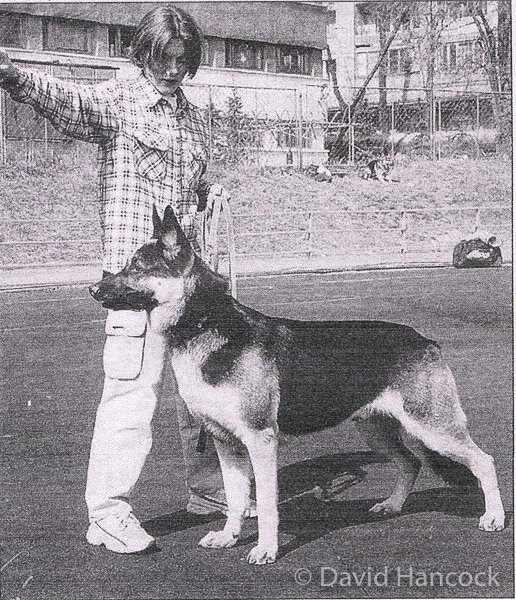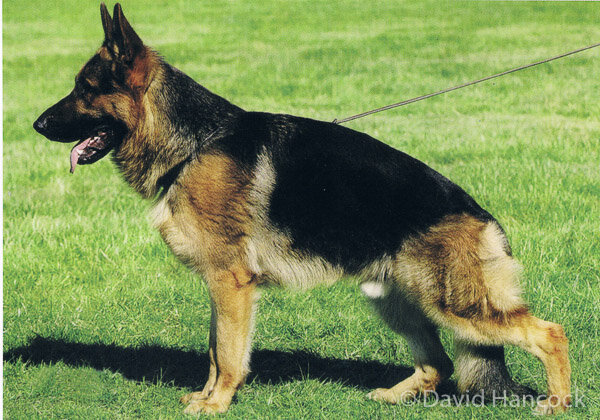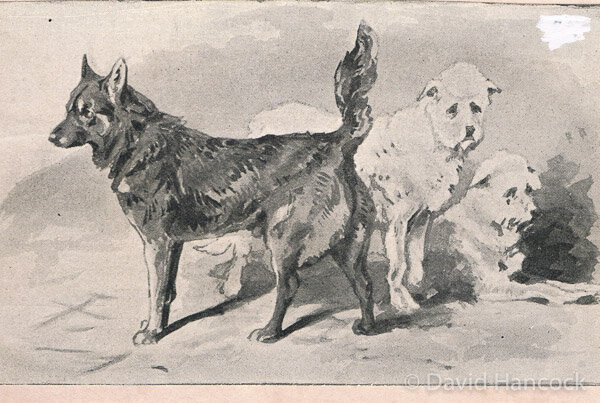1167
BRING BACK THE ALSATIAN
By David Hancock
The despair over the decline of the German Shepherd Dog during the last century is well illustrated by the creation of 'offshoots' like the Eastern European Shepherd, the Saarloos and the Czech Wolfdogs, and, mainly in North America, the King Shepherd, the Shiloh Shepherd and the Panda Shepherd Dogs. But now, the Thames Valley Police Dog Section has produced their version and an impressive version it is. Half a century ago, when working in London, I walked behind a Metropolitan Police dog-handler as he patrolled a nearby street in Whitehall. I was appalled by the 'back-end' of his GSD! The dog was badly cow-hocked as well as bent-backed, with no power from behind and a distinct lack of fluid movement overall. The dog had clearly been obtained from a show breeder rather than 'bred for the job'. Sadly, the dog's handler seemed oblivious to the basic flaws in his dog. For such a fine breed to descend to this was extremely sad. Dog may be man’s best friend but the concept of man as dog’s best friend is very wide of the mark.
It is foolish to regard any dog registered with the KC as a purebred product as having true type just because it is a registered pedigree dog. Type in any breed of dog is far more subtle and a lot more elusive than that. For me dogs with the genuine look of their breed are always to be preferred to untypical specimens with "papers". Is a German Shepherd Dog with a roach back, hyper-angulation in its hindquarters and a lack of substance, with two show-ring wins and KC registration to be preferred to an upstanding, well-boned and symmetrically built dog with a level topline but no papers? Contemporary GSD breeders seem to have lost their way and it's going to take decades to restore true type to this quite outstanding breed. I wholeheartedly agree with Lady Malpas, who wrote a decade ago to one of the dog papers: "There can be no justification for any attempt, accidental or intentional, to produce different types of German shepherd." I also support the view of a GSD breed correspondent who questioned 'What has happened to this noble breed? I was brought up in the school that had as a pattern dogs like Ch. Fenton of Kentwood, Ch. Sergeant of Rozavel and dogs of similar type. My mentors told me that a good Alsatian could carry a glass of water on its back without spilling when moving...' What ever makes a breed-clique alter a breed to its disadvantage? The first show Alsatians I ever saw, as a young teenager, were from the celebrated 'of Novem' kennel and had a topline for any breeder to die for! The ‘of Picardy’ dogs were greatly admired too.
In Germany, the 'breed wardens' for the GSD wield enormous power. It was therefore good to read that a new (2013) breed warden has taken a long hard look at the breed and outlined his main priorities: health and agility, return to the Standard, a broadening of the bloodline basis or gene pool and reduction of inbreeding, the promotion of working ability and, significantly, opposition to the trend of breeding look-a-like 'clones', wherein every dog in the breed resembles the next one - the dreaded 'cookie-cutter' dogs. The last point is of interest; how do you breed to the Standard without producing dogs of almost exact appearance? It could lead to a temporary loss of breed type, but it might also result in the best working dog physique being favoured over rows of extremely handsome identical dogs - all with the same faults.
The service to man of the German Shepherd Dog is difficult for any other breed to match. I have seen them at work and witnessed their versatility in nearly twenty different countries. I had always considered their breed type to be fixed. Unlike manufactured breeds like the Dobermann and the Leonberger, there is no risk of a strong prototypal ancestor-breed like the Greyhound or the Bulldog manifesting itself. Any breeder who tampers with a breed type long established, long accepted and long proven able to produce an intelligent, healthy, biddable dog is a dangerous, misguided maverick who should be halted in his tracks. In any breed of pedigree dog it only takes one determined breeder with more money than sense to promote his concept or a dominant clique to gain ascendancy for true type to be threatened. Breeds don't just lose type; breeders lose their way. But who lets them? The KC really must appoint Breed Councils as the guardians of each breed – it is truly a high priority.
Despite being able to trace its ancestry back to the native sheep dogs of Thuringia and Wurtemberg (and if the old name of ‘Alsatian’ is flawed, then the white dogs could be called GSD (Pomerania) and the black ones GSD (Wurtemberg)) rather as the varieties of the Belgian Shepherd Dog are identified), I believe it is fair to state that the GSD has ceased to be a pastoral dog and should now be regarded as a service dog. I believe it is also fair to state that for a century at least it was the most widely-used service dog in the world. That is some tribute to the early breeders. It is not any solace to the breeders of today however to see that retrievers, purebred and crossbred, are replacing the GSD as guide-dogs, the police in many European countries are turning towards the Malinois for their needs, with spaniels being preferred for drug, contraband and bomb-search work. The ubiquitous Border Collie is emerging as the best-equipped, all-round, multi-purpose service dog, mainly because of its biddability and wide-ranging natural talent, but also through its physical robustness, which means lower maintenance costs for the user. The harm done to the GSD breed by misguided faddists is incalculable. In their important book on the breed, The Complete German Shepherd Dog of 1983, breed experts Nem and Percy Elliott wrote: “The breed definitely went wrong of that there is no doubt. To get things back on an even keel, is what’s necessary, i.e.: back to the balanced dog, of correct type. For some that is not enough. They wish to continue to exaggerate their breeding plans; but in the opposite direction! Consequently, there are those who wish their dogs to be shorter than normal, with sloping and raised backlines, half-starved during puppyhood so as not to be too heavy; and this is equally wrong. Those of us with the necessary experience, have to continue to try and guide the development of the breed on the right lines. I think we shall succeed, but time will tell.” This makes sad reading and I wish them and their enlightened colleagues eventual success. No farmer could afford to breed deformed dogs! And no police force would want to use them.
One of the best security dogs in the Armed Forces in recent years was a white German Shepherd Dog. Captain von Stephanitz, a pillar in the development of the breed, once wrote: "our German sheepdogs have never been bred for colour, the latter being of complete indifference in a working dog." I haven't seen that written in more recent times. I can understand the very sensible wish to avoid breeding albinos and to retain good pigmentation but find it hard to justify penalising a really good dog because of the colour of its coat. Solid black dogs are rarely shown but used by the German police service. The breed’s gene pool is far wider than the black and tan show ring versions choose to depict. Old images of German sheepdogs show solid-coloured dogs – and merle specimens!
The Pomeranian sheepdog, now lost to us, was a pure-white German sheepdog. The dog acknowledged as the foundation dog of contemporary German Shepherd Dog bloodlines, Horand von Grafrath, born in 1895, had a white grandsire. But after the death of von Stephanitz, white dogs were discriminated against, leading to their disqualification in Germany and then in America in 1968, from conformation shows. One was however the top obedience German Shepherd in America in 1968. In 1978, a white dog was the top dog in the US police canine association and a white Canadian GSD police-dog has been credited with over 200 arrests and rated highly. I can find nothing but admiration for the white GSDs in the Hoof Print kennel of Joanne Chanyi in Ontario; why should such admirable dogs not be accepted on merit?
In 1968, the German Shepherd Club of America voted to 'disqualify' white dogs in its breed standard. For the first time in its history, since its 1913 establishment, registered purebred dogs were banned on colour grounds alone. But breed historians have discovered that of the thirty dogs identified as 'pillars of the modern breed of GSD', 18 either produced white dogs or had direct descendants which were white, often continuing white bloodlines through lots of early champions. Dr Neufeld writing in 1970 gave the view that: "...white shepherd dogs played a paramount role in creating the remarkable German Shepherd Dog...are intimately intertwined with and all but inseparable from the breed generally." For playing that foundation role the white GSD then gets banned!
I know of no reports linked to authoritative research which documents any deficiencies in white GSDs linked to their colour. On the contrary, Dr Eugene Carver, in a 1984 article in the reputable Journal of Heredity on coat colour genetics in the GSD, wrote that vets who have examined white GSDs reported that they had observed no physical abnormalities or mental problems associated with the white dogs. Whole volumes of information exist from breeders, owners, vets, breed historians, geneticists and scientific researchers indicating that white GSDs are normal in every way. A survey of 53 breeders of white GSDs, involving 5,320 white dogs, conducted in 1988, established that only a single dog was reported to be deaf. Any rational explanation of prejudice towards white GSDs would be likely to be found in human behaviour rather than in the genotype of the breed itself.
If breed type, real breed type, not ‘flavour of the month’ or false phenotypes compounded over recent years by show ring whim or temporary fashion, actually matters, and I do believe it does, an argument could be made for ‘starting again’. By that I mean the drawing-up of the correct historical type for each native pastoral breed from the earliest depictions, principally from very old photographs, then by a programme of planned breeding, re-creating or restoring that type in each of our native pastoral breeds. For breeders, both here and in Germany, to ruin such an outstanding breed as the GSD, in such a relatively short period of time, takes some doing - and for the kennel clubs of the world to condone such destruction is extremely worrying. For modern breeders to ruin the superb anatomy handed down to them by this breed’s ‘fathers’ is tantamount to a betrayal! The back-end of this once-distinguished breed is often ‘towed’ and not a propelling force.
In every animal walking on four legs the force derived from pressing the hind foot into the ground has to be transmitted to the pelvis at the acetabulum, and onwards to the spine by way of the sacrum. In over-angulated dogs the locomotive power is directed to an inappropriate part of the acetabulum. In addition, so as to retain the required degree of rigidity of the joint between the tibia and the femur, other muscles have to come into use. In the over-angulated hind limb, the tibia meets the bottom end of the femur at such an angle that direct drive cannot ensue. The femur can only transmit the drive to the acetabulum after the rectus femoris muscle has contracted, enabling the femur to assume a degree of joint rigidity when connecting with the tibia. This means that the femur rotates anticlockwise whereas nature intended it to move clockwise.
Excessive angulation in the hindquarters, with an elongated tibia, may, to some, give a more pleasing outline to the exhibit when 'stacked' in the ring. But, in the long term, it can only lead to anatomical and locomotive disaster. Such angulation destroys the ability of the dog's forelimbs and hindlimbs to cooperate in harmony in propelling the body. Yet I have heard it argued by breed specialists at seminars that it will increase the power of propulsion operating through the hindlimbs and on through the spine. If it did, the racing Greyhound fraternity would have pursued it with great vigour. I have heard a dog show judge praise an over-angulated dog because it 'stood over a lot of ground'! So does a 'stretched limousine' but it requires a purpose-built, specially-designed construction to permit the luxury.
When are we going to stop valuing our precious breeds of dog on their appearance alone, when it's their temperament that makes them a successful companion animal? Breeding for the pedigree and show-ring success is not the activity of either a real dog-lover or a true breed-lover; it can become a hobby for the mindless pursuit of winning for winning's sake, and it ruins distinguished breeds. In one half-century the Alsatian is renowned for its level topline, in the next it is desired to feature a 'banana-back' with its tail dragging along the floor. Such specimens may have great pedigrees, but they are not great dogs. Genuine dog-lovers know the difference! Sound dogs impress; unsound ones just suffer - in silence. Their pedigree never speaks!

























